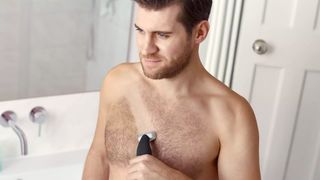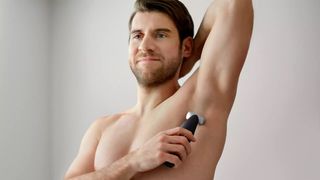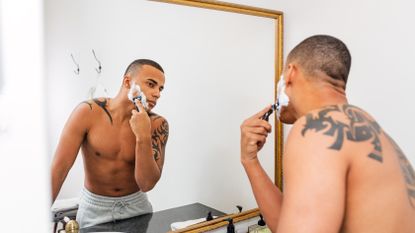While the term itself is a cringeworthy one, to say the least, “manscaping” doesn’t only refer to the modern man’s hopeless attempt at trimming the pubic region like it once did. Over the years, the term has evolved to mean anyway in which said man cultivates the superfluous fur that grows in the regions below the neck.
Some would argue that manscaping is now a standard routine for most male grooming habits. Hence the rise in popularity of the best body groomers. But don’t just take our word for it. According to a study by Cosmopolitan, 69% of men prefer trimming their pubic hair, while only 10% leave it growing wherever it pleases. It’s not just about vanity, either. Manscaping cleans up your look, improves your hygiene and can help boost your self-confidence.
Ultimately, there’s no right or wrong way to trim the hair on your body - it’s all about personal preference; how you want to look and how it makes you feel. So whether you’re new to the world of grooming, or already an experienced manscaping practitioner, be sure to follow our below tips to ensure you avoid any nicks, cuts or breakouts.

Manscaping And Body Grooming: Areas
Let’s look at how best to approach the different areas of your body when it comes to taming that fur.
Back and shoulders
The back is probably one of the biggest bugbears for hairy people, not only because it’s hard to reach but because it’s seen as one of the most unattractive areas to have excessive hair. In our experience, professional IPL laser treatment is the best course of action for getting rid of fuzz in this area, a treatment that we’ll talk about in more depth in the ‘Methods’ section, further down.
Arm pits
If you like to wear vests in summer but don’t love the bush that protrudes from under your pits, it might be worth giving this area some grooming love. We wouldn’t recommend shaving it, but seen as armpit hair holds onto odour and sweat, trimming it back with scissors or a body trimmer on a long length setting will mean you won’t need to use as much deodorant.
Backside
Whether your buttocks are covered in a peach-like layer of fluff, or you’re the proud owner of a downstairs comb-over, never take a razor to your buttocks. As the area of your body that you sit on daily, it runs the risk of causing some major itchiness and ingrown hairs. A body trimmer is your best bet. Make sure you leave the safety guard on, though, just in case.
Chest
Unless your chest closely resembles that of King Kong, you shouldn't need to trim this area that much. Especially since we believe every man should be proud to own a good chest of hair. However, if it’s a little overkill, you could use a body groomer set to a length of around 5mm to hack it back a bit. This will decrease the hair volume without losing the overall effect. A good tip is to start trimming in the middle of the chest and if you’re happy go from there. If the hair is really full in the centre, try trimming a sharp horizontal line down the middle and it’ll give the effect of bigger pecs.
If you want to continue down the ‘treasure trail’ to the tummy, dial the comb down to 3mm or so. If you’re lucky enough to have abs, this will keep them visible and in proportion without looking too bare.
Pubic area
You’re best off using a specific body grooming device when it comes to the family jewels, it’s not somewhere you want to let loose the hair clippers or beard trimmers, especially since the latter is used on the face. Although be extra careful using electric trimmers in this area, it’s proven to trap bacteria so even a minor cut can cause infection. To get around this, make sure not to let the blades of your device touch the actual skin, pulling it taught as you go.
We’d recommend any length between 1 and 3mm for everything except the balls. This will leave you feeling clean and fresh without causing ingrown hairs, itchy stubble or razor burn. If you like your sack as smooth as silk, again, don’t shave. Trim as close as possible. You could always try the Balls Trimmer, a device specially formulated to glide over the nads without causing any nicks, cuts or irritation.

Manscaping And Body Grooming: Methods
Here are some of the different methods you can use when it comes to keeping hair under control, and the best way to use them.
Trimming
There are a plethora of tools out there for trimming all types of body hair as opposed to removing it entirely. The is the top pick in best body groomer buying guide, though. With an integrated trimmer at one end, and the close-shaving foil at the other, you’re getting all lengths covered wherever you’re trimming - comfortably. The best bit? it can be picked up for not very much money at all.
Waxing
Waxing can be painful and can result in an acne breakout. If you see a trusted professional, however, you can avoid most problems. Katie Godfrey, founder, KG Salons says waxing is popular with men before the summer holiday season, especially for the back and chest.
“We recommend waxing as it leaves you hair-free for a good few weeks and it grows back finer each time you have it done,” she explains.
Laser hair removal and IPL
Laser hair removal is one of the best ways to permanently get rid of unwanted hair. It’s a very popular method for men, especially in places they never want to see any hair growth again, such as the back. While there are great gadgets available for home use, (the Philips’ Lumea Prestige IPL and Braun’s Silk-expert IPL machines are some of our favourite tried-and-tested devices in the best IPL machine buying guide), professional lasering conducted in salons is the most effective, mostly because the machines are way more powerful.
Last year, we tried a course of treatment of the state-of-the-art Primelase laser at the Nova Aesthetic Clinic in London and saw brilliant results. You’ll need six sessions at least for permanent removal, but each session will result in thinner and lighter regrowth.
If you’re more into the idea of home lasering, be aware that this method is less effective for people with lighter hair or a darker skin colour, as skin expert Dr Ross Perry of Cosmedics Skin Clinics in London, explains: “If you have dark skin or light hair, laser hair removal at home will rarely work because the dark pigment absorbs the laser and it can result in a burn. Many home lasers have sensors which block them from working on darker skin.”
Shaving
Shaving is generally a big no-no when it comes to keeping body hair in check. Wherever you use it, it’s bound to cause irritation and aggravate the skin, causing rashes or spots. If you have no other tools at your disposal, however, Popular British aesthetics doctor, Dr Ahmed El Muntasar, advises that skin is cleansed properly before shaving and that your razor is clean.
“Firstly, always shave after a hot shower as the hairs are softer and easier to remove,” he tells T3. “Then, shave along the grain of the hair which reduces the likelihood of irritation and ingrown hairs.”
Depilatory creams (Veet)
A depilatory cream, such as , offers a quick, convenient and safe way to remove unwanted hair without the precision (or irritation, in most cases) of shaving. They work by breaking down the keratin structure of the hair, which thins and dissolves the base of the hairs to the point where they are weak enough to be broken off when the cream is wiped away. These creams can be used on most areas of the body, but be sure not to use it on sensitive or broken skin.
Liked this?
- Remove body hair with the best body groomer
- Looking to shave your face? Try the best electric shaver and best beard trimmer
- Get your dental routine on-point with the best electric toothbrushes
- Hate body hair? Get rid of it completely with the best IPL machine



